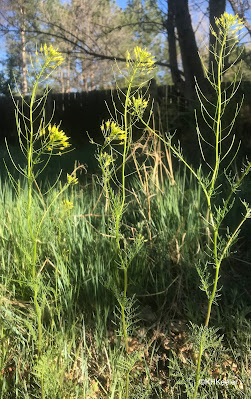As a group, the plants in the mustard or cabbage family, Brassicaceae, are cool weather plants, growing well early in the spring, flowering as the temperatures warm, going to seed in the heat of summer. Familiar mustards are cabbage (Brassica oleracea), broccoli (Brassica oleracea), and mustard itself (mustards are species of Brassica, Rhamphospermum and Sinapsis). These edible mustard family plants were domesticated in Eurasia and they are a small selection of the more than 3,700 species worldwide. North America has 634 native species in the mustard family. It also has more than 100 exotic mustards.
But, oh, they are difficult to tell apart!
Members of the mustard are relatively easy to recognize. In addition to flowering in spring, almost all have four petals in a cross pattern. An alternative name for the family is Cruciferae, referring to that cross shape of the flowers. Most mustards have yellow flowers, some have white flowers, and a minority are blue-purple. So flower shape isn't helpful and flower color will only help you identify one or two species. Mustards have diverse and interesting seed pods, helpful in identification, if the plant has seeds. The key in Ackerfield's Flora of Colorado begins with the type of hairs on the plant. So you need to have the plant, unless the photo was extremely close-up and detailed.
 |
| Dame's rocket, Hesperis matronalis, relatively easily identified-- because of the flower color--but an invasive exotic mustard |
 |
| Flixweed, Descurainia sophia a bit over 2' tall |
Here is flixweed, also called tansy mustard and herb sophia, Descurainia sophia, a weedy mustard from Europe. It appeared along a path in my yard, suggesting it was exotic and carried in on shoes. It is small and the leaves are feathery. The finely divided leaves are quite different from many other yellow mustards, letting me spot it picture books of weeds. Then I went to more technical works, to compare the details, to make sure it was this species and not a closely-related one.
Flixweed turns out to be quite interesting. It came to North America, probably stowed away in grain, more than 200 years ago and is now found all over the continent including well north into Canada and south into Mexico, except, curiously, Alabama and Florida. The genus Descurainia has eight North American species, all native except for this one. Ackerfield gives tansy mustard for the common name of all the natives and calls D. sophia flixweed. The USDA Plants database calls all the natives tansy mustard and this exotic, herb sophia. |
| Flixweed, Descurainia sophia |
 |
| Divided leaves of flixweed, Descurainia sophia |
 |
| Flixweed, Descurainia sophia |
Comments and corrections welcome.
References
Ackerfield, J. 2023. Flora of Colorado. 2nd edition. BRIT Press, Fort Worth, Texas.
Common Tansymustard. Descurainia sophia (L.) Webb ex Prantl. no date given Montana Plant Life link(Accessed 5/8/24).
Nimrouzi, M. and M. M. Zarshenas. 2016. Phytochemical and pharmacological aspects of Descurainia sophia Webb ex Prantl: modern and traditional applications. Avicenna J. Phytomed. 6(3): 266-272. link (Accessed 5/10/24).
Whitson, T. D. editor. 1992. Weeds of the West. Western Weed Science Society. Newark, California.

No comments:
Post a Comment